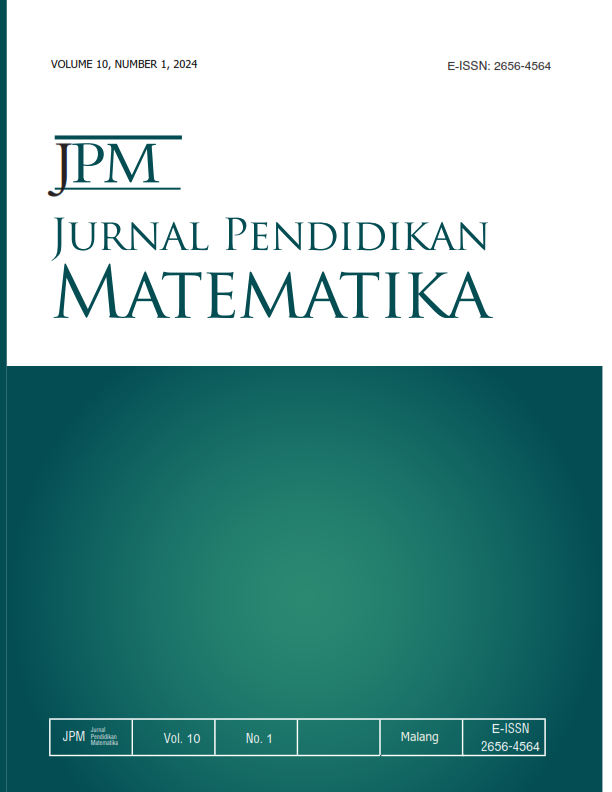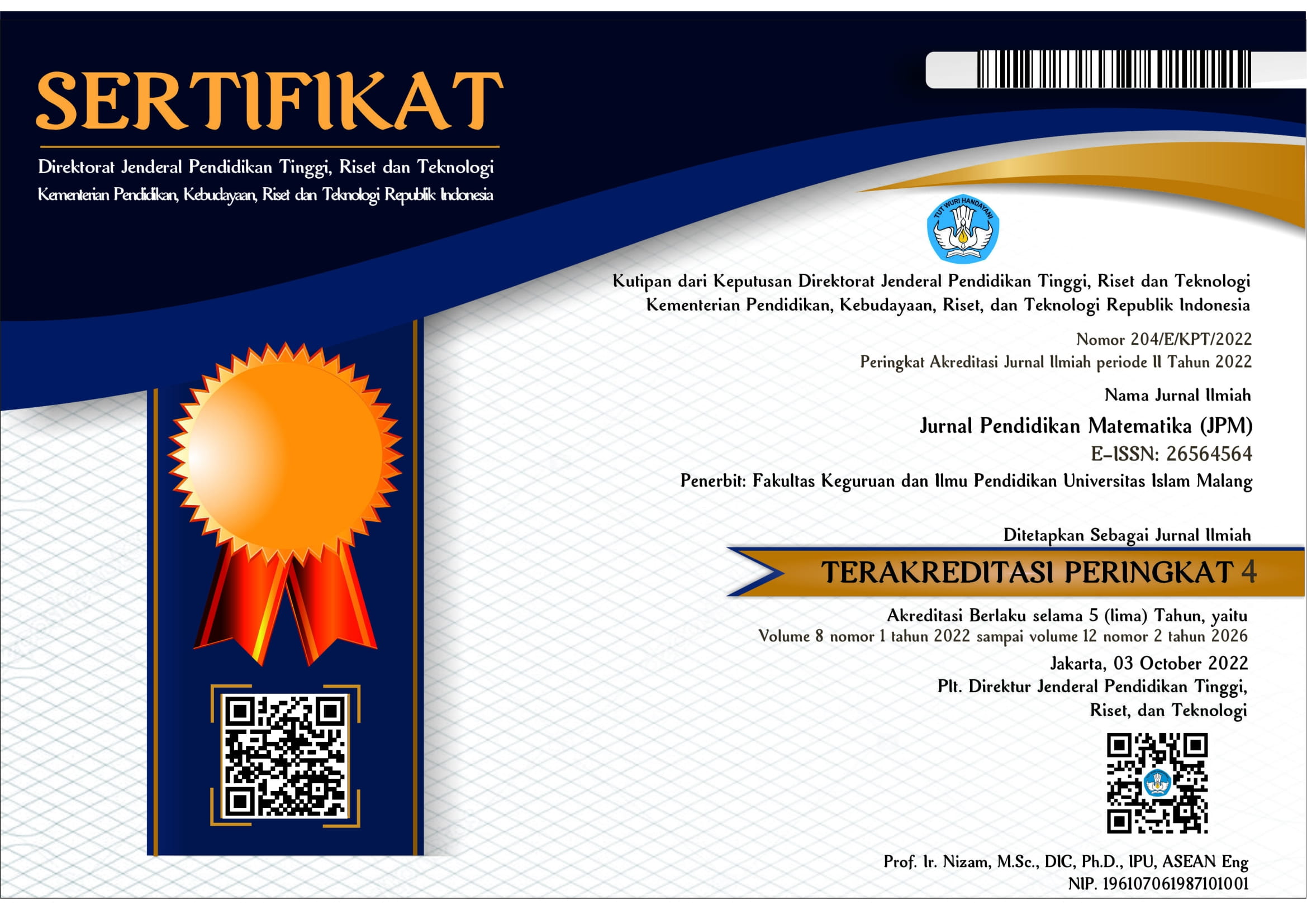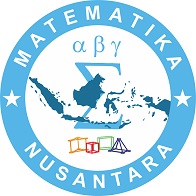The Process of Translating a Linear Program Problem into A Mathematical Representation
DOI:
https://doi.org/10.33474/jpm.v10i1.20506Keywords:
Translation Process, Mathematical Representation, Problem SolvingAbstract
This research aims to describe the representation translation process in solving linear programming problems. The representation translation process will be explained at each stage of problem-solving according to Polya. The types of representation that will be explained are algebraic, numerical, graphic, and verbal. This research uses a descriptive qualitative approach. The research subjects consisted of two mathematics education students taking linear programming courses. Both subjects are students with high mathematical abilities who have good communication skills so that researchers can explore more in-depth information about the representation translation process. The instrument in this research is a linear program test which consists of two problems. The research results showed that subject 1 (S1) and subject 2 (S2) fulfilled three stages of problem-solving, namely understanding the problem, making a plan, and implementing the plan. Both subjects used all four representations in solving problems. The translation process that occurs starts with exploring sources, compiling initial knowledge, building targets, and determining suitability.
References
Adu-Gyamfi, K., Stiff, L. V., & Bossé, M. J. (2012). Lost in Translation: Examining Translation Errors Associated With Mathematical Representations. School Science and Mathematics, 112(3), 159–170. https://doi.org/10.1111/j.1949-8594.2011.00129.x
Anwar, R. B., Yuwono, I., As’ari, A. R., Sisworo, & Rahmawati, D. (2016). Mathematical representation by students in building relational understanding on concepts of area and perimeter of rectangle. Educational Research and Reviews, 11(21), 2002–2008. https://doi.org/10.5897/err2016.2813
Bal, A. P. (2014). The Examination of Representations used by Classroom Teacher Candidates in Solving Mathematical Problems. Educational Sciences: Theory & Practice, 14(6), 2349–2365. https://doi.org/10.12738/estp.2014.6.2189
Bossé, M. J., & Chandler, K. (2014). Students ’ Differentiated Translation Processes. International Journal for Mathematics Teaching and Learning, 828.
Brahier, D. (2010). Teaching secondary and middle school mathematics. https://doi.org/10.4324/9781315685502
Irawati, S., & Hasanah, S. I. (2016). Representasi Mahasiswa Berkemampuan Matematika Tinggi Dalam Memecahkan Masalah Program Linier. Prosiding Seminar Matematika Dan Pendidikan Matematika, 18(Inovasi), 80–86.
Kowiyah, & Mulyawati, I. (2018). An analysis of primary school students’ representational ability in mathematics based on gender perspective. Journal of Physics: Conference Series, 948(1). https://doi.org/10.1088/1742-6596/948/1/012016
Maryani, A., & Setiawan, W. (2021). Analisis Kesulitan Siswa Dalam Menyelesaikan Soal Sistem Persamaan Linear Dua Variabel Pada Kelas VIII. MATH-EDU: Jurnal Ilmu Pendidikan Matematika, 6(3), 100–114. https://doi.org/10.32938/jipm.6.3.2021.100-114
Monariska, E., & Komala, E. (2021). Analisis Kemampuan Representasi Matematis Mahasiswa Pada Mata Kuliah Program Linear. Jurnal Edukasi Dan Sains Matematika (JES-MAT), 7(1), 43–58. https://journal.uniku.ac.id/index.php/JESMath/article/download/3884/2616
National Council of Teacher of Mathematics. (2000). Principles and Standards for School Mathematics. In School Science and Mathematics (Vol. 47, Issue 8). https://doi.org/10.1111/j.1949-8594.2001.tb17957.x
Polya, G. (1973). How to Solve It Mathematical Method.
Puspitasari, N. D. (2022). Analısıs Representası Matematıs Sıswa SMP dalam Memecahkan Masalah Arıtmatıka Sosıal.. Jurnal Ilmiah Pendidikan Matematika, 11(3). https://jurnalmahasiswa.unesa.ac.id/index.php/mathedunesa/article/view/25554/23429
Putri, O. R. U., & Zukhrufurrohmah. (2022). Proses Translası Permasalahan Realıstık Menjadı Representası Matematıs Mahasıswa Teknık Informatıka. 11(2), 1343–1354.
Rahmawati, D. (2019). Translatıon Between Mathematıcal Representatıon : How Students Unpack Source Representatıon ? 7(1), 50–64.
Rahmawati, D., Purwantoa, P., Subanji, S., Hidayanto, E., & Anwar, R. B. (2017). Process of Mathematical Representation Translation from Verbal into Graphic. International Electronic Journal of Mathematics Education, 12(4), 367–381. https://doi.org/10.29333/iejme/618
S, A., Juniati, D., & Sulaiman, R. (2019). Students’ Mathematical Representation in Geometry Problem Solving Based Sex Differences. International Journal of Trends in Mathematics Education Research, 2(4), 184–187. https://doi.org/10.33122/ijtmer.v2i4.94
Siang, J. J. (2011). Riset Operasi dalam Pendekatan Algoritmis (pp. 1–353).
Tripathi, P. N. (2008). Multiple representations, III. Mathematics Teaching in the Middle School, 13(8).
Downloads
Published
How to Cite
Issue
Section
License
Copyright (c) 2024 Nur Hasanah Syarief, Agustin Fatmawati

This work is licensed under a Creative Commons Attribution 4.0 International License.






_-_Copy.jpg)
.jpg)
.jpg)










